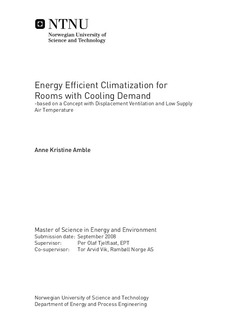| dc.contributor.advisor | Tjelflaat, Per Olaf | nb_NO |
| dc.contributor.advisor | Vik, Tor Arvid | nb_NO |
| dc.contributor.author | Amble, Anne Kristine | nb_NO |
| dc.date.accessioned | 2014-12-19T11:48:36Z | |
| dc.date.available | 2014-12-19T11:48:36Z | |
| dc.date.created | 2012-11-08 | nb_NO |
| dc.date.issued | 2008 | nb_NO |
| dc.identifier | 565824 | nb_NO |
| dc.identifier | ntnudaim:4375 | nb_NO |
| dc.identifier.uri | http://hdl.handle.net/11250/234699 | |
| dc.description.abstract | AbstractIn relation to new building directives and regulations there is much focus on energy efficiencyand reducing the use of electricity. There is therefore a need for ventilation systems with lowSpecific fan power (SFP) and to limit or avoid the need for mechanical cooling.At the same time questions are raised concerning whether increasingly complicatedventilation systems are the best way to achieve energy efficiency. They are more vulnerablefor poor design and maintenance which especially school buildings have suffered from.This has led to the development of several natural and hybrid ventilation concepts. One ofthese which has had success in school buildings the last 15 years in Sweden and Norway isthe so-called Swedish model. Characteristic of this solution is that sub terrain culverts areused for passive cooling and heating of the ventilation air which passes through double innerwalls and is supplied to the room high on the inner wall. The supply air falls towards the floormixing in the surrounding air and spreads along the floor as displacement flow with an outletin the ceiling. This works particularly well in classrooms where the high occupation densitycreates a cooling demand large parts of the year. These schools therefore have a very low SFPfactor and no mechanical cooling.In the following report a classroom model with the Swedish ventilation concept is studiedwith the aim of developing a method of dimensioning such air flow. CFD simulations areused to confirm expected behaviour and the resulting thermal comfort and air quality attypical winter, spring and summer scenarios. Finally a Guide for preliminary design andsizing for climatization of rooms with cooling needs using the Swedish model is presented.The most important results were that there was a good correspondence between the empiricalcalculations and CFD simulations. Adequate carbon dioxide levels and temperature can beachieved without use of primary energy for heating at for outdoor temperatures above 5 ºC.There was a substantial risk of draft unless a near zone of 2-3 m is used. However the CFDmodel was limited to a slice of the classroom and the accuracy of the results suffers somewhatfrom this.Guidelines are developed for preliminary design and sizing of supply air plumes based onempirical expressions of air flow by Eimund Skåret(2000) and can be found in the appendix. | nb_NO |
| dc.language | eng | nb_NO |
| dc.publisher | Institutt for energi- og prosessteknikk | nb_NO |
| dc.subject | ntnudaim:4375 | no_NO |
| dc.subject | MTENERG energi og miljø | no_NO |
| dc.subject | Energibruk og energiplanlegging | no_NO |
| dc.title | Energy Efficient Climatization for Rooms with Cooling Demand: -based on a Concept with Displacement Ventilation and Low Supply Air Temperature | nb_NO |
| dc.type | Master thesis | nb_NO |
| dc.source.pagenumber | 125 | nb_NO |
| dc.contributor.department | Norges teknisk-naturvitenskapelige universitet, Fakultet for ingeniørvitenskap og teknologi, Institutt for energi- og prosessteknikk | nb_NO |

